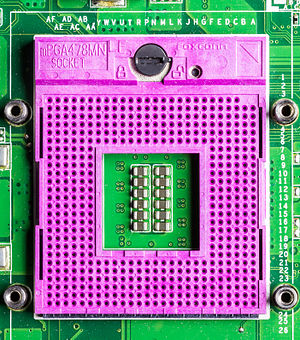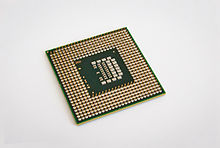Socket P
(Redirected from Socket p)
This article needs to be updated. (December 2018) |
 | |
| Type | PGA |
|---|---|
| Chip form factors | Flip-chip pin grid array |
| Contacts | 478 (not to be confused with the older Socket 478 or the similar Socket 479) |
| FSB frequency | 400 MT/s, 533 MT/s, 667 MT/s, 800 MT/s, 1066 MT/s |
| Processors |
|
| Predecessor | Socket M |
| Successor | rPGA 988A |
This article is part of the CPU socket series | |
The Intel Socket P (mPGA478MN) is the mobile processor socket replacement for Core microarchitecture chips such as Core 2 Duo. It launched on May 9, 2007, as part of the Santa Rosa platform with the Merom and Penryn processors.
Technical specifications[edit]

The front-side bus (FSB) of CPUs that install in Socket P can run at 400, 533, 667, 800, or 1066 MT/s. By adapting the multiplier the frequency of the CPU can throttle up or down to save power, given that all Socket P CPUs support EIST, except for Celeron that do not support EIST. Socket P has 478 pins, but is not electrically pin-compatible with Socket M or Socket 478. Socket P is also known as a 478-pin Micro FCPGA or μFCPGA-478. On the plastic grid is printed mPGA478MN.
See also[edit]
External links[edit]
- https://web.archive.org/web/20060714182555/http://dailytech.com/article.aspx?newsid=2835
- https://web.archive.org/web/20060709190425/http://www.dailytech.com/article.aspx?newsid=3180
- http://www.anandtech.com/cpuchipsets/showdoc.aspx?i=2808&p=4
